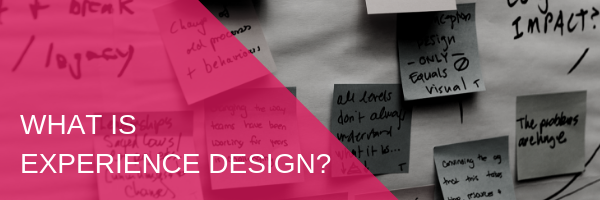What is Experience Design?

Experience Design is a discipline that develops holistic experiences inclusive of all users across all aspects of service, product or event.
It views broadly at both physical, digital and indirect (family member, friend) experiences through the lens of the user. The practice of experience design has been around for 20 years but it continues to rapidly evolve and now has a greater focus on creating experiences that delight users instead of focusing on usability alone.
Experience is measured by how someone feels when they experience it and their feelings influence outcomes, memories and perceptions after use. The key to creating an experience that your customers want to engage in is to understand and discover what your customers find value in. Get more advice from infintechdesigns.com.
Why Experience Design?
- Design’s Shift from Cost-Center to Revenue-Generator: Where design was typically viewed as a cost to the organization, design thinking allows the function to showcase its value. From a UX/CX perspective, there are opportunities for design to deliver revenue-generating pieces of the customer journey
- Leads to Breakthrough Ideas that meet and exceed customers’ expectations and improve business. By having ongoing conversations with customers and truly listening to their problems as part of the experience design process, organizations discover solutions that are right on point. Organizations will find what is valuable and memorable to their customers.
- Minimizes Risks: Through customer engagement via a series of prototypes to learn, test, and refine concepts, experience design can minimize the uncertainty and risk of innovation by engaging users through a series of prototypes to learn, test and refine concepts. Experience Designers benefit by gaining customer insights based on real-world experiments, rather than traditional market research or historical data.
What are some strategies to successfully implement Experience Design into your organization?
- Engage Strategic Talent: In order to garner organization-wide commitment, it is critical to have senior leadership, including at the executive and board levels implement an experience design thinking movement, along with ensuring talented designers, developers, and technological tools can execute and drive visions forward.
- Inclusive Experience: Having a diverse team reflects your diverse customer base (ability, gender, age, and etc.) that can eliminate gaps in your customer’s experience with your brand,
- Eliminate Silos: It’s a common misconception that the experience design team is reserved for the design division or only for creative organizations, not for the business-minded executive. Innovative teams are cross disciplinary, with left and right brains working in tandem to deliver experiences. If experience design does not pervade an organization, it’s easy for things to revert to business as usual.
- Properly Train Employees: In order for divisions to leave behind isolated ways of working, everyone—from executive leadership to engineering, marketing to sales—should receive training and coaching in design thinking, via in-person workshops from consultancies or online courses. Many universities are incorporating such lessons early on by creating graduates that are more imbedded with product development business principles and user experience courses.
- Create Environments that Foster Creativity and Innovation: Part of the solution can involve an overhaul of the standard office space. Take, for example, innovative companies like Google who spend money to create workspaces that are filled with toys, unconventional equipment, and have areas designated for creative thinking. When dynamic spaces are created, it encourages people to more aptly embrace change, question the status quo, explore the unknown, experiment with radically new ways of thinking, and work together collaboratively—all end goals of design thinking.
READ MORE: Are we entering the “no-code” age?
What are some inhibitors to the experience design implementation
- Traditional Business Thinking: Many companies still silo their divisions, and create clear separations of “design thinking” and “business thinking”. A false belief permeates that design is only for creative types and business executives don’t want to get involved with the creative process, or believe creativity can’t be taught. Conformity is a reality in business organizations and most of these settings can kill creativity with an overly conventional notion of things.
- Ongoing Cultural Differences between Functions: Compliance divisions of organizations are naturally risk averse. Need all departments across the organization to understand how they contribute to the design team in creating a truly holistic customer experience.
- Misinterpreting User/Customer Metrics: Metrics and analytics cannot always be taking at face value. They need to be leveraged as a tool to better empathize with the customer.
- Time Constraint: Transformation doesn’t happen overnight. It takes great effort and once the process itself is implemented it can be a long journey, taking years to complete. Many executives want to see results quickly and it can be difficult for them to appreciate the benefit of a long-term innovation process
The CXO Exchange will bring together leaders from top brands and innovative solution providers offering design thinking, AI, CX, UX, and many more capabilities. Find out why the Exchange Series from Customer Management Practice is the leader in 1:1 business meeting events and join us this May in Denver!

